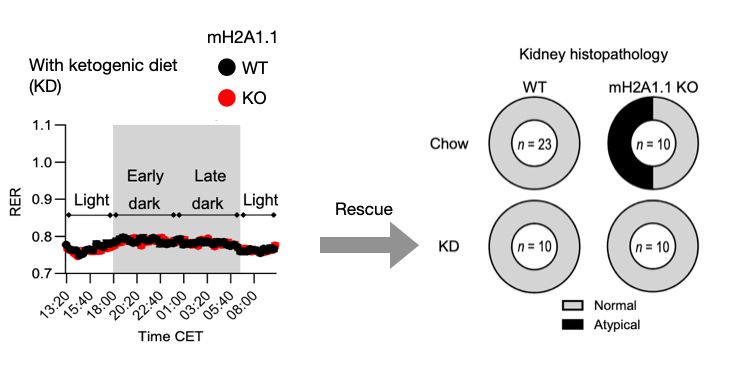
Marcus Buschbeck and Lab
@marcusbuschbeck.bsky.social
Senior Group Leader at Josep Carreras Institute.
Chromatin; Nucleal metabolism; Leukemia; MDS; Drug Targets; Histone variants.
Posting about the lab and the wider scientific community.
More info about us here: www.buschbecklab.org
Chromatin; Nucleal metabolism; Leukemia; MDS; Drug Targets; Histone variants.
Posting about the lab and the wider scientific community.
More info about us here: www.buschbecklab.org
7/7
We would like to thank:
- Our collaborators from the teams of Emily Bernstein, Manlio Vinciguerra and
@poberdoerffer.bsky.social for advice and samples.
- Our editor Navdeep Chandel for his guidance.
- And most importantly, all members of my lab for support on all levels.
We would like to thank:
- Our collaborators from the teams of Emily Bernstein, Manlio Vinciguerra and
@poberdoerffer.bsky.social for advice and samples.
- Our editor Navdeep Chandel for his guidance.
- And most importantly, all members of my lab for support on all levels.
October 30, 2025 at 9:56 AM
7/7
We would like to thank:
- Our collaborators from the teams of Emily Bernstein, Manlio Vinciguerra and
@poberdoerffer.bsky.social for advice and samples.
- Our editor Navdeep Chandel for his guidance.
- And most importantly, all members of my lab for support on all levels.
We would like to thank:
- Our collaborators from the teams of Emily Bernstein, Manlio Vinciguerra and
@poberdoerffer.bsky.social for advice and samples.
- Our editor Navdeep Chandel for his guidance.
- And most importantly, all members of my lab for support on all levels.
6/7
Conclusion: Chromatin composition integrates with metabolic regulation at the NAD⁺ interface. Loss of macroH2A1.1 decouples chromatin–mitochondrial crosstalk, shifting nutrient flux toward glycolysis and instigating secondary organ dysfunction.
Conclusion: Chromatin composition integrates with metabolic regulation at the NAD⁺ interface. Loss of macroH2A1.1 decouples chromatin–mitochondrial crosstalk, shifting nutrient flux toward glycolysis and instigating secondary organ dysfunction.
October 30, 2025 at 9:56 AM
6/7
Conclusion: Chromatin composition integrates with metabolic regulation at the NAD⁺ interface. Loss of macroH2A1.1 decouples chromatin–mitochondrial crosstalk, shifting nutrient flux toward glycolysis and instigating secondary organ dysfunction.
Conclusion: Chromatin composition integrates with metabolic regulation at the NAD⁺ interface. Loss of macroH2A1.1 decouples chromatin–mitochondrial crosstalk, shifting nutrient flux toward glycolysis and instigating secondary organ dysfunction.
5/7
A ketogenic diet, enforcing lipid oxidation and lowering NAD⁺ demand, normalized RER, glucose tolerance, and liver gene profiles, completely preventing kidney abnormalities. Thus, diet overrode the metabolic phenotype associated with macroH2A1.1 loss.
A ketogenic diet, enforcing lipid oxidation and lowering NAD⁺ demand, normalized RER, glucose tolerance, and liver gene profiles, completely preventing kidney abnormalities. Thus, diet overrode the metabolic phenotype associated with macroH2A1.1 loss.

October 30, 2025 at 9:56 AM
5/7
A ketogenic diet, enforcing lipid oxidation and lowering NAD⁺ demand, normalized RER, glucose tolerance, and liver gene profiles, completely preventing kidney abnormalities. Thus, diet overrode the metabolic phenotype associated with macroH2A1.1 loss.
A ketogenic diet, enforcing lipid oxidation and lowering NAD⁺ demand, normalized RER, glucose tolerance, and liver gene profiles, completely preventing kidney abnormalities. Thus, diet overrode the metabolic phenotype associated with macroH2A1.1 loss.
4/7
This was secondary to a systemic shift in metabolism. Respiratory exchange measurements (RER) indicated reduced oxidation of lipids and increased glucose utilization — consistent with a Warburg-like shift. This was accompanied by alterations in NAD+ metabolism.
This was secondary to a systemic shift in metabolism. Respiratory exchange measurements (RER) indicated reduced oxidation of lipids and increased glucose utilization — consistent with a Warburg-like shift. This was accompanied by alterations in NAD+ metabolism.

October 30, 2025 at 9:56 AM
4/7
This was secondary to a systemic shift in metabolism. Respiratory exchange measurements (RER) indicated reduced oxidation of lipids and increased glucose utilization — consistent with a Warburg-like shift. This was accompanied by alterations in NAD+ metabolism.
This was secondary to a systemic shift in metabolism. Respiratory exchange measurements (RER) indicated reduced oxidation of lipids and increased glucose utilization — consistent with a Warburg-like shift. This was accompanied by alterations in NAD+ metabolism.
3/7
Mice lacking macroH2A1.1—but not macroH2A1.2 or macroH2A2—developed inflammatory lesions and hyaline casts in kidneys of both sexes, independent of local transcriptomic changes, implicating systemic rather than renal-intrinsic dysfunction.
Mice lacking macroH2A1.1—but not macroH2A1.2 or macroH2A2—developed inflammatory lesions and hyaline casts in kidneys of both sexes, independent of local transcriptomic changes, implicating systemic rather than renal-intrinsic dysfunction.

October 30, 2025 at 9:56 AM
3/7
Mice lacking macroH2A1.1—but not macroH2A1.2 or macroH2A2—developed inflammatory lesions and hyaline casts in kidneys of both sexes, independent of local transcriptomic changes, implicating systemic rather than renal-intrinsic dysfunction.
Mice lacking macroH2A1.1—but not macroH2A1.2 or macroH2A2—developed inflammatory lesions and hyaline casts in kidneys of both sexes, independent of local transcriptomic changes, implicating systemic rather than renal-intrinsic dysfunction.
2/7
This is the product of team effort coordinated by René Winkler. A decade of collaboration between our group and the team of Raffaele Teperino @epitep.bsky.social and the German Mouse Clinic led by Martin Hrabě de Angelis @helmholtzmunich.bsky.social.
This is the product of team effort coordinated by René Winkler. A decade of collaboration between our group and the team of Raffaele Teperino @epitep.bsky.social and the German Mouse Clinic led by Martin Hrabě de Angelis @helmholtzmunich.bsky.social.
October 30, 2025 at 9:56 AM
2/7
This is the product of team effort coordinated by René Winkler. A decade of collaboration between our group and the team of Raffaele Teperino @epitep.bsky.social and the German Mouse Clinic led by Martin Hrabě de Angelis @helmholtzmunich.bsky.social.
This is the product of team effort coordinated by René Winkler. A decade of collaboration between our group and the team of Raffaele Teperino @epitep.bsky.social and the German Mouse Clinic led by Martin Hrabě de Angelis @helmholtzmunich.bsky.social.
Thank you, Manfred.
August 21, 2025 at 4:22 PM
Thank you, Manfred.

